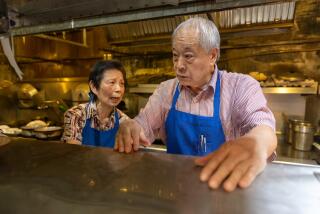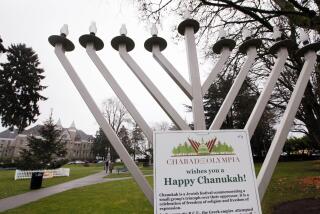Chinese Jew Enrolls in U. S. School to Trace Family’s Lost Roots
- Share via
Qu Yinan, a Beijing journalist, knew nothing of her Jewish ancestry until 1981.
She always thought her family was Muslim, if anything, because they never ate pork.
But one day four years ago her mother, a sociologist, went to an international conference and by chance heard about the little-known Jewish community of China, which is now virtually extinct.
The speaker said that a list of the Jewish families that once flourished at Kaifeng, a town on the Yellow River, included the name Jin, and added that a Prof. Jin was a descendant of that clan.
Prof. Jin turned out to be Qu Yinan’s great-uncle, who had died some years before.
“Everybody was surprised,” said Qu, now 26 and a student at the University of Judaism campus overlooking the Sepulveda Pass.
The surprise was understandable, since Chinese Jews, never more than a few thousand in number, had become almost totally assimilated by the mid-19th Century, after a history going back at least as far as the Sung Dynasty--between the years 960 and 1126.
Cultural Injunctions
Qu’s grandfather, who was born in Kaifeng, remembered some Jewish rituals and passed on to his children the cultural injunctions against eating pork and shellfish, Qu said. He also wore the blue skullcap that was traditional among Chinese Jews, as opposed to the white skullcap of the more numerous Muslim minority.
But the next generation, swept up in the turbulent events of China’s recent history, retained none of its exotic past.
Once her interest was aroused, Qu found that there was little or no information to be had in China about the subject.
So when her mother published an article entitled “I Am a Chinese Jew” in a scholarly journal, it drew attention at home and abroad.
“It was the first public declaration by anyone of that community of their Jewishness,” said Rabbi Josh Stampfer of Portland, Ore., who met the family in Beijing during a 1983 visit and found them eager to learn about the subject.
“You can’t take courses about Judaism in China,” Qu said. “I wanted to find out more about Judaism. I also want to write back to China about it.”
Venture Abroad
That curiosity led to an invitation from Stampfer to come to the United States, and approval a year later by the Chinese authorities for her unprecedented venture abroad to study Jewish topics.
Arriving in Portland last year, Qu stayed with the rabbi’s family and learned to speak English fluently before moving to Los Angeles to begin work on a master’s degree in Jewish studies.
Motivated more by scholarly interest than religious feelings, Qu said she hopes to write articles or perhaps a book about Judaism and the world Jewish community for a publication in China.
Although there may have been other Jewish communities in ancient China, Kaifeng is the only one about which there is any real information.
Origin Mysterious
Its origin is somewhat mysterious, but the few scholars who have studied the matter concluded that the original families most likely came from Persia via India.
Stone inscriptions testify to more than 1,000 years of communal life at Kaifeng, sustained for much of that time by contact with the established Persian communities farther along the old Silk Road, the overland link between China and the West.
The Kaifeng Jews maintained their identity even after China’s contact with the outside world was cut off by imperial decree around the year 1500, but their knowledge of religious practice and Hebrew slowly decayed.
Maintained Traditions
Still, they faced west toward Jerusalem in prayer, gave their children both Jewish and Chinese names, trained their own rabbis and other religious functionaries and repeatedly reconstructed their synagogue after floods, fires and the devastations of war.
When the Jesuit missionary Matteo Ricci met the Jewish mandarin Ai T’ien in 1605, he assumed him to be a Christian, according to “The Jews of Kaifeng,” a book published by Bet Hatfuzoth, Israel’s Museum of the Jewish Diaspora.
Ricci’s reports to Rome provide some of the best information about the Kaifeng Jews, but contact was maintained only sporadically after that and, by 1850-51, when Western visitors returned, the centuries of isolation and intermarriage had taken their toll.
The synagogue was in ruins, and no one could read the Torah scrolls and other holy books, which eventually were sold and made their way to Western museums.
Still, Rabbi Stampfer said, he found 100 to 150 people who considered themselves Jewish when he visited Kaifeng in 1983.
“They don’t have any practices or knowledge but they have a sense of identity,” he said.
More to Read
Sign up for Essential California
The most important California stories and recommendations in your inbox every morning.
You may occasionally receive promotional content from the Los Angeles Times.













